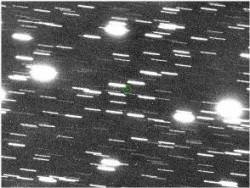Sorry to disappoint those of you hoping for some Martian fireworks the end of this month. NASA's Near Earth Object (NEO) Program office has effectively ruled out the possibility of Asteroid 2007 WD5 impacting Mars. The probability of such an event has dropped dramatically, to approximately 0.01% or 1 in 10,000 odds of an impact. Observers also say the asteroid has no possibility of impact with either Mars or Earth anytime in the next century.
Recent tracking measurements of the asteroid from several Earth-based observatories have provided a significant reduction in the uncertainties of the asteroid's position during its close approach to Mars on Jan. 30, 2008. The best estimates now have 2007 WD5 passing about 26,000 km (16,155 miles) from the planet's center at approximately 12:00 UTC (4:00 am PST) on Jan. 30th. The NEO office at the Jet Propulsion Laboratory has 99.7% confidence that the pass should be no closer than 4000 km (2,485 miles) from Mars' surface.
The 50 meter (164 feet) wide asteroid was discovered in late November of 2007 by astronomers at the University of Arizona as part of the Catalina Sky Survey. Other telescopes used to track the asteroid are the Kitt Peak telescope in Arizona, the Sloan Digital Sky Survey telescope in New Mexico, New Mexico Tech's Magdalena Ridge Observatory, the Multi-Mirror Telescope in Arizona, the Mauna Kea telescope in Hawaii and the Calar Alto Observatory in Spain.
An impact on Mars by 2007 WD5 could have created a .8 km (1/2 mile) wide crater on the planet's surface. Many scientists were excited by the prospect of such an event, one that could possibly be tracked by the many spacecraft orbiting and on the surface of the red planet.
NASA's Spaceguard Survey continually searches for Near-Earth Asteroids such as 2007 WD5, and their goal is to discover 90% of those larger than 1 km in size. JPL's NEO office says that goal should be met within the next few years. Each discovered asteroid is continually monitored for the possibility of impact on Earth.
Original News Source:
Near Earth Object Program press release
 Universe Today
Universe Today
